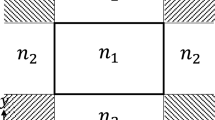Abstract
The work presents a comparison between results of optical simulations based on the scalar and vectorial models applied to both stripe – geometry Fabry-Perot (FPL) as well as vertical-cavity surface-emitting (VCSEL) diode lasers designed for the 1.3-μm optical–fibre communication. As compared to vectorial optical approaches, scalar ones are known to be less exact but simultaneously they need as many as approximately 100 times shorter computation time, which favours those models in many applications. Therefore, vectorial models should be applied only in cases of confirmed faulty performance of scalar ones. While the Effective Index Method and the Effective Frequency Method have been chosen as scalar approaches to FPLs and VCSELs, respectively, simulations, the Method of Lines has been used in both cases as a vectorial one. Scalar models have been found to be quite exact in the case of a determination of the effective refractive index and wavelength of emitted radiation, whereas their exactness in the lasing threshold analysis is much worse, especially in the case of higher-order modes. Our analysis is concluded with the determination of the regions where both models give satisfactorily close results.
Similar content being viewed by others
References
S. Adachi (1992) Physical Properties of III-Y Semiconductor Compounds Wiley New York
M.J. Bergmann H.C. Casey SuffixJr. (1998) J. Appl. Phys. 84 1196–1203 Occurrence Handle10.1063/1.368185 Occurrence Handle1998JAP....84.1196B
O. Conradi S. Helfert R. Pregla (2001) IEEE J. Quant. Electron 37 928–935 Occurrence Handle10.1109/3.929594
T. Czyszanowski M. Wasiak W. Nakwaski (2001) Opt. Appl. 31 313–323
D.W. Jenkins (1990) J. Appl. Phys. 68 1848–1853 Occurrence Handle10.1063/1.346621 Occurrence Handle1990JAP....68.1848J
Kondo T., Arai M., Onomura A., Miyamoto T., and Koyama F.,. 2002 IEEE/LEOS Annual Meeting Conference Proceedings, Piscataway, 2, 618, 2002.
P. Maćkowiak W. Nakwaski (2000) J. Phys. D 33 642–653 Occurrence Handle10.1088/0022-3727/33/6/309 Occurrence Handle2000JPhD...33..642M
U. Rogge (1991) Method of Lines for the Analysis of Dielectric Waveguides FernUniversitat Hagen
G. Steinle H. Riechert A.Yu. Egorov (2001) Electron. Lett. 37 93–95 Occurrence Handle10.1049/el:20010098
Wasiak M. Optical Gain in the Laser with a Quantum Active Region, MSc dissertation, Technical University of łódź, 1999.
H. Wenzel H-J. Wünsche (1997) IEEE J. Quant. Electron 33 1156–62 Occurrence Handle10.1109/3.594878
Author information
Authors and Affiliations
Corresponding author
Rights and permissions
About this article
Cite this article
Czyszanowski, T., Nakwaski, W. Validity of Scalar Approaches to Radiation Modes of the GaAs-Based 1.3-μm Diode Lasers Designed for the Optical–Fibre Communication. Opt Quant Electron 38, 349–360 (2006). https://doi.org/10.1007/s11082-006-0033-6
Received:
Accepted:
Issue Date:
DOI: https://doi.org/10.1007/s11082-006-0033-6




